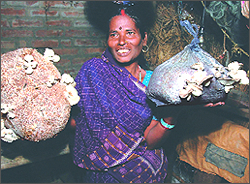Farmers in areas of Uganda are being asked to plant tea instead of sorghum. The government will supply subsidized seedlings and will open a processing factory that will buy the leaves. The main motive is that tea earns double the income of sorghum. That may be, and diversification is a good thing, but I wonder whether the income from tea will buy as much nutrition as the sorghum it replaces.
Enset bags
Via Timbuktu Chronichles comes news that a Ugandan company called African Skin has won the Business in Development Challenge. African Skin makes attractive bags and other accessories from the outer layers of fibre of the enset plant (see also here for the role of enset in food security in Ethiopia), which can be sustainably harvested. “The Business in Development (BiD) Challenge is the first international business plan competition for entrepreneurship and development. The BiD Challenge offers entrepreneurs worldwide the opportunity to develop and execute business plans that improve living standards in developing countries at a profit.”
No longer in the dark about mushrooms
From India to South America. If you want to see how one farm has diversified into mushroom production, our friend Andy Jarvis has posted a set of informative photographs to flickr, the image sharing web site.
Mushrooming success
 Sometimes it is hard to keep up with the pace of news. A week ago The Indian Express ran a story about Lal Muni Devi, a poor landless woman who had made a great success of turning wheat waste into mushrooms. Lal Muni had not even heard of mushrooms four years ago. Researchers from the Indian Institute for Agricultural Research turned up and trained 25 women from her village to grow mushrooms, and she was one of the most successful. Reason enough to report. But the reason The Indian Times seems to have published the story now is that Lal Muni Devi featured in a news story from CIMMYT, the International Centre for the Improvement of Maize and Wheat, more than a year ago! No matter, it is always good to read about successes in diversifying species to boost incomes.
Sometimes it is hard to keep up with the pace of news. A week ago The Indian Express ran a story about Lal Muni Devi, a poor landless woman who had made a great success of turning wheat waste into mushrooms. Lal Muni had not even heard of mushrooms four years ago. Researchers from the Indian Institute for Agricultural Research turned up and trained 25 women from her village to grow mushrooms, and she was one of the most successful. Reason enough to report. But the reason The Indian Times seems to have published the story now is that Lal Muni Devi featured in a news story from CIMMYT, the International Centre for the Improvement of Maize and Wheat, more than a year ago! No matter, it is always good to read about successes in diversifying species to boost incomes.
Photo by Paras Nath from The Indian Express
Ethiopian herbs promoted
The Ethiopian Biodiversity Conservation Institute has reported on a variety of efforts to conserve and make better use of medicinal plants. Lots of interesting snippets of information, and some ideas others may find worthwhile. Head on over to AllAfrica.com for the story. The Institute has a web site here, with medicinal plants here. There’s also one for the Institute of Biodiversity Conservation and Research. I can’t figure out the relationship between the two.